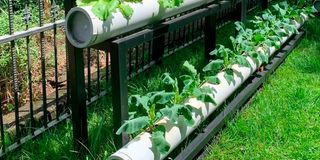Tana farmers ponder hydroponic farming amid climate change effects

Elizabeth Onyango, Ukulima Tech CEO, showcases one of their hydroponics vertical step gardens in a backyard in Nairobi. Tana farmers now thinking of hydroponic farming amid climate change effects.
What you need to know:
- It involves the production of food under optimal conditions, in a solution of high-nutrient contents.
- Crops under hydroponic farming are propagated without topsoil.
- For people with small farms, this model can help them achieve 100 times more productivity annually than normal harvests.
Intermittent rainfall patterns resulting from climate change have made once-cherished agriculture a nightmare for residents of Tana River County.
Pests and diseases have not made it any better, wreaking havoc on most farms, and leaving farmers in a desperate position.
Some have had to abandon farming after losing all their capital to a series of calamities resulting from climate change, while others are on the verge of giving up.
"Our case started with drought for a season, then came the rains, and while we were optimistic about getting a bountiful harvest, the locust invasion happened, and after the locust invasion, came a disease that affected our crops followed by drought. We have suffered," said famer Ali Maro.
Traditional farming, he added, has become unpredictable and is more of a gamble than a routine practice.
The soil, he lamented, has lost its grit and barely produces much as it used to, putting the practice of food production in danger.
"Sometimes I think I should venture into something else, maybe beekeeping for honey or just start a shop to fetch me an income. However little, it will sustain me," he said.
Mr Maro is not the only farmer facing these challenges. Other farmers across the county, including mango growers, have been affected.
To counter the effects of climate change on agriculture, the Tana River government, in partnership with the United Nations Development Programme, is teaching young people and farmers a new farming technique, hydroponic farming.
Unlike traditional farming, which depends on soil and massive artificial irrigation to achieve a harvest, this mode of smart farming removes the need to have soil to do agriculture.
It involves the production of food under optimal conditions, in a solution of high-nutrient contents.
Crops under hydroponic farming are propagated without topsoil but in a liquid nutrient solution with the natural ingredients of potassium and sodium, said Prof Dominic Mwenja, an expert in hydroponics.
"It is where you propagate healthy vegetables free of pesticides in a small space that has its temperature controlled," he said.
Controlled environment
Unlike in open farming where nutrients are shared across all organisms, in this controlled environment, the organisms are eliminated and the soluble nutrients are fed into the water for the roots.
The practice incorporates pumice and coco peat to help in anchoring the plants.
Pumice helps in moisture regeneration and aeration and reduces water runoff and the need for fertilisation by increasing soil absorption.
"It helps in absorbing excess moisture so roots don't rot and further stimulates growth," Prof Mwenja said.
Coco peat, on the other hand, is used as an alternative to soil because it is naturally anti-fungal and crops grown in it mature twice faster.
Prof Mwenja said this system of farming is appropriate for counties in arid and semi-arid areas where droughts are common.
For people with small farms, he said, this model can help them achieve 100 times more productivity annually than normal harvests.
"For instance, what one makes in an eighth of an acre piece of the farm is equivalent to what another will make in half an acre in an open farm. In hydroponic farming an eighth of an acre gives you more than 3,800 crops," he said.
A model farm has reaped its first harvest since hydroponic farming was introduced, increasing productivity by 100 percent.
Farmers in the county are excited about the idea and are upbeat that it will address the effects of climate change and reduce inter-ethnic conflicts.
They note that any extra space can be used for other activities in agribusiness or create other opportunities in agriculture.
"We all need to be assured of 100 percent yields and harvests. This is normally challenged by various factors that eventually affect livelihoods, so this idea is worth trying," said farmer Asha Salim.
But she notes that the idea is best implemented through cooperatives, which would make it affordable and easier to manage.
This is an idea whose time has come, said County Secretary Mwanajuma Mabuke, and it will help Kenya bolster food security.
"It is an idea that could be endearing to the youth who are perceived not to be much into farming, because it embraces technology unlike working in the fields," she said.
The model will support more than 300 young people trained in hydroponic farming to venture into farming, she added.
To start them off, the administration has set up a Sh75 million programme, called Inuka Fund, where interested youth can apply for funding.
"The market is short of a lot of products. We get our vegetables from sellers more than 500km away and by the time they get here, they are expensive. We can reduce the cost and the time lost in between," Ms Mabuke said.
Ms Mabuke urged young people to take the challenge and attack the market with smart agriculture as it is the future as the climate changes.





